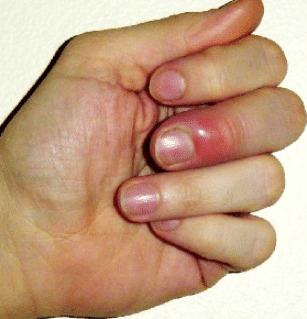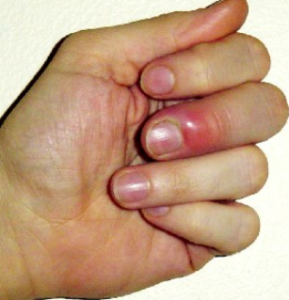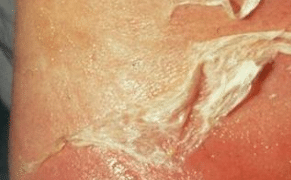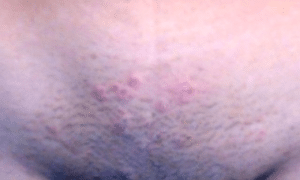Infected finger is a common problem. The infection can range from being minor to severe, even causing a complete damage to the affected finger. The infection can start as a small lump that can easily be treated. In case you fail to treat the infection you may end up losing the entire finger due to the infection. Identifying the infected finger early enough and carrying out required treatment may help to prevent very serious outcomes.
Infected Finger Causes
An infection usually is caused by an organism that takes advantage of certain weaknesses of the body. In most cases, organisms that cause infection may take advantage of a broken skin so that they enter the body through the wound to cause infections.
Moreover, people with weak immune system are always at risk of developing an infected finger if they have any wound that will allow an organism into the skin since their body is weak enough not to prevent them from infection.
We have talked about numerous types of infections that take place on your finger. However, there are a number of things that cause these infections and they include the following:
What causes finger infection?
- Bacteria
According to most of the infections we have discussed above, bacteria are the most organisms that cause finger infections. The major types of bacteria organisms that cause infected finger are staphylococcus and streptococcus types of bacteria. The organisms enter the body through an open wound. Usually some traumas on the finger are the ones that introduce the organism into the body. The infections may differ depending on how they start and a particular location on your finger where it develops.
- Virus
Viral infections may as well be the cause of your infected finger. However, as we discussed above, the only infection that is caused by viral organisms is herpetic whitlow, which is usually as a result of herpes simplex virus I or II. The virus is introduced to the finger by getting exposed to any liquid that contains the virus.
Risk factors for developing finger infection
There are numerous factors that will expose you finger infections. As we discussed above, every infection has a starting point and specific area where it targets. Some of these factors may include the following:
- Open wounds on the fingers
- Deep cuts
- Penetrating trauma or injury
- Picking hangnails
- Picking of your cuticles
- Nail biting
- Aggressive manicure or cuticle trimming
There are some cases whereby an individual may be highly susceptible to infected fingers than others. Some of the conditions that facilitate this include:
- People with diabetes
- People with weak or poor immune system
- People who are always exposed to disease causing organisms such as the dentists and nurses
- People in occupations that involves the hands being exposed to water all through their duties.
What are the symptoms of infected finger?
Symptoms usually vary according to the infection an individual is suffering on his or her finger. The signs and symptoms are the ones that make a certain infection unique from the others and it may cause some confusion if not properly evaluated.
- Symptoms for paronychia
The symptoms for this condition may include redness and swelling on the infected area on the fingernail there may be a visible sack of pus under the skin in the infected area under nail plate. If the sack is pierced, the fluid flows out of the wound. Also, the area is usually painful and tender to touch. The pus is usually cloudy white in color.
- Symptoms for felon
In this case the affected fingertip is usually swollen and painful. The swelling usually occur after several days of the infection and it is located in the pad of the affected fingertip. The area usually has throbbing pain and it may be painful to touch.
There may be a single or numerous open wounds in the infected area. The area may be red with a collection of pus at the center of the wound under the skin. Also, there area is usually tender to touch. As the swelling continues, the area of the infected finger may start becoming tense or hard to touch.
- Symptoms for herpetic whitlow
Herpetic whitlow may be seen with the following symptoms:
- Redness and tenderness of the fingertip area
- Burning and itchy sensation from the affected area
- A mild swelling not as much as the felon case
- Single or numerous open wounds in the affected area
- The area may ooze a clear fluid though in some cases may have a slightly cloudy color
- The affected person may have a low grade fever and have swollen and tender lymph nodes in the area
- Symptoms for cellulitis
Signs and symptoms for this condition may include redness on the affected skin and warmth emerging from the area. The area may be slightly swollen and tender. Cellulitis is often a superficial infection and therefore the deep structure is not involved. The motion of the fingers and hand should not be difficult or painful with this infection. If it happens to be difficult of painful, it may indicate a deep space infection of some king.
- Symptoms for infectious flexor tenosynovitis
There are four major signs that are usually associated with this kind of infection. These signs are usually referred to as kanavel cardinal signs. These signs may not be present at first or All at once. The first sign is the tenderness that occurs on the flexor or palm side of the finger. This pain is usually found over the tendons in the finger.
Another sign is the uniform swelling of the infected finger. The third one is the pain that extends or straightens the infected finger. The fourth sign usually involve the finger being held in a slightly flexed or partially bent position.
- Deep space infection symptoms
The main condition that occurs with deep space infection in the web space of the finger is called collar button abscess. The signs and symptoms associated with the condition may involve the following:
- Pain and swelling in the web space of the fingers
- Redness and warmth from the infected area
- As the abscess enlarges, the fingers slightly spread apart with the increase of pressure
- Collection of pus at the center of the infected area under the skin.
Types of Finger Infections
There are numerous types of infections that can occur on your finger.
- Paronychia
This is an infection of the finger that involves the tissues that are found on the edges of the finger nail. Paronychia infection is often superficial and may attack the soft tissue and the skin that surround the finger nail. It is known to be the bacterial infection that affects hands in many cases.
The bacteria involved in this case are usually staphylococcal and streptococcal organisms. It is very rare for a fungus to cause this infection, which may begin as a hangnail. In most cases, the person affected may try to bite the piece of nail that hangs at the corner of the nail pallet, which may result to hangnail infection.
The infected finger can also be caused by aggressively shoving back or trimming your cuticles which may result to cuticle infection. The open wound on your cuticles may allow bacteria to enter the skin and bacteria in the mouth may infect the wound. The infection will then spread to the surrounding tissue on your nail and cuticle.
- Felon
This is an infection that affects the tip of your finger. Felon infection usually affects the fingertip pad and the soft tissue that is found around it. It is caused by the same bacteria that cause paronychia, and the bacteria may take advantage of a punctured wound. The wound allows the bacteria to enter deep into the skin tissue of the fingertip pad. Due to the multiple compartments found in the fingertip, the infection is contained there.
- Herpetic whitlow
This is a viral infection that affects the fingertip. It is the most common type of viral disease that affects human hand. In most cases, people misdiagnose the disease as paronychia or felon. The virus that causes this disease is known as herpes simplex virus I or II. It is the same virus that usually causes oral herpes or genital herpes infections.
People who live in certain occupation are more at risk of the infection as compared to others. Some of these people may include the dentists, physicians, nurses, or any other person who may have direct contact with saliva of oral herpes infected person or any fluid containing the organism. Also, people suffering from oral or genital herpes may infect their fingers.
- Cellulitis
This is a superficial infection that affects the skin and the tissues that are found underneath. Most of the tissues affected are those that are found on the surface and not deep down in the structure of your infected finger.
Cellulitis is a bacterial infection that is caused by type of bacteria known as staphylococcus and streptococcus organism. The bacteria normally enter the body through an open wound whereby it may infect the local tissue and skin. The infection can as well spread to the hand and fingers through blood flowing to the area while it carries the organism.
- Infectious flexor tenosynovitis
This is the infection that attacks the tendon sheaths responsible for flexing and closing of the hand. The disease is also a type of deep space infection and in most cases it occurs in people who have a poor immune system. The infection is caused by bacteria penetrating an open wound to result in an infected finger.
- Deep space infection
It is an infection that affects one of the deep structures on the hand and fingers, such as the tendons, inner blood vessels, and the muscles of the infected hand. The infection may cover one or more of these structures.
One type of this infection is a collar button that usually develops in the web space of the fingers. The deep structure of your fingers may create numerous potential compartments that will allow this infection to take place.
Infected Finger Cut
As we have seen, most of the infections that occur on the finger usually take advantage of a broken skin to enter the wound and cause an infection. It is very important to carry out after care activities immediately on the broken skin so that you can prevent any opportunistic organisms from causing an infection on the wound. We have talked about bacteria which is the major cause of infected finger. Usually, bacteria enter the body through a wound, and therefore result in bacterial infections.
Usually, a cut on the finger if not treated and applied antibiotic creams may be an easy way a disease causing organism can get into the body. Usually, if exposed to germs, they may enter the skin and within a few days you may start to realize some of the symptoms that we have discussed above to indicated that your finger cut is infected. Some of the signs and symptoms of an infected finger may include:
- Pain and tenderness of the infected finger
- Pus-filled sack at the center of the wound
- Swelling of the infected area
- Reddening or the area
You can prevent a cut on your finger from being infected by immediately carrying out a first aid after you get a cut, such as washing the wound with antiseptic soup and warm water, then letting it to dry before applying antibiotic cream. Then you have to cover the wound with a bandage to prevent any germs from the outside from entering the cut.
Swollen Infected Finger
Swelling is one of the major symptoms you should look at to ascertain that your finger is infected. Most of the infections that we have discussed above usually signify swelling as one of their major signs and symptoms. However, the size of the swelling may vary from one infection to another. For example, all of the bacterial infections we have discussed usually result in a swollen infected finger.
In case of a swollen infected finger, you can bring down the swelling by a warm compress and draining out the pus before applying a proper treatment so as to reduce the infection. If the swelling is so large, this means that the infection is at its severe stages and therefore medical intervention should be done to cub the infected finger.
Infected Finger Pictures
All these types of finger infections we have talked about above can be differentiated from one another according to the area the infection took place, and according to the symptoms presented by a certain infection.
Different infections occur at different areas of the finger such as the fingertip, finger pad, nail pallet, in between fingers, and on the cuticles. We have provided numerous pictures that will enable you to evaluate these different types of infections that take place on your finger.
How to treat an infected Finger
The diagnosis of an infected finger usually begins with finding out the history of the infection and physical examination. A direct history of your condition will help to find out the likely cause and therefore correct diagnosis.
People with localized finger infection will be treated differently than some who have a chronic or serious infection. Underlying conditions such as diabetes or blood vessels disorders of the arms and legs may cause more complications to the infected finger and may cause the treatment to be more complicated.
The doctor may need to know the following information:
- How the injury or the infection began
- When the infection first occurred
- Specific area where it occurred on the finger
- If it is possible a foreign body is in the wound
- If you have done any care to the wound before visiting the doctor
- When you last had tetanus shot
- Any previous injuries to the area
Treatment may involve the use of pain relievers and antibiotic medications in case the infection was caused by a bacterial infection. In the case of viral organisms, antiviral drugs and creams may be used. Most of the prescribed drugs can be acquired over the counter.
Note: a delay in treatment of serious condition may result in disability or loss of the finger, and therefore you should not hesitate to get medical care.
Finger infection Home Remedy
Usually, an infected finger is due to poor home care and not carrying out preventive measures in case you get a cut or develop a wound. A very minor condition can be managed at home and prevent occurrence of a major infection. The following are some of the home remedies that may help to reduce an infection in your finger.
- Warm salty water compress
Warm water will help to facilitate the movement of fluids in the vessels around the infected finger and therefore facilitate healing. Also, the infection is brought to the surface by warm water so that it can be released in form of pus.
Salt on the other hand help in the suppressing of disease causing bacteria. Moreover, warm water compress will help to bring down the swelling. Just heat some water with some salt and use a clean cloth to compress the solution on the wound or swelling.
- Apple cider vinegar
This home remedy contains natural antibacterial properties that will help in the fighting of germs from bacteria. Also it may help in the fighting of fungal infections in the fingernails. In case the home remedy does not provide required results, you may consult your medical provider.
More references
- Finger infection: https://www.emedicinehealth.com/finger_infection/article_em.htm
- Causes of finger infections: https://www.webmd.com/a-to-z-guides/finger-infection
- Natural treatments for nail cuticle infections: https://www.livestrong.com/article/266136-best-natural-treatments-for-nail-cuticle-infections/
- Home remedy for an infection in a finger: https://www.leaf.tv/articles/home-remedy-for-an-infection-in-a-finger/











